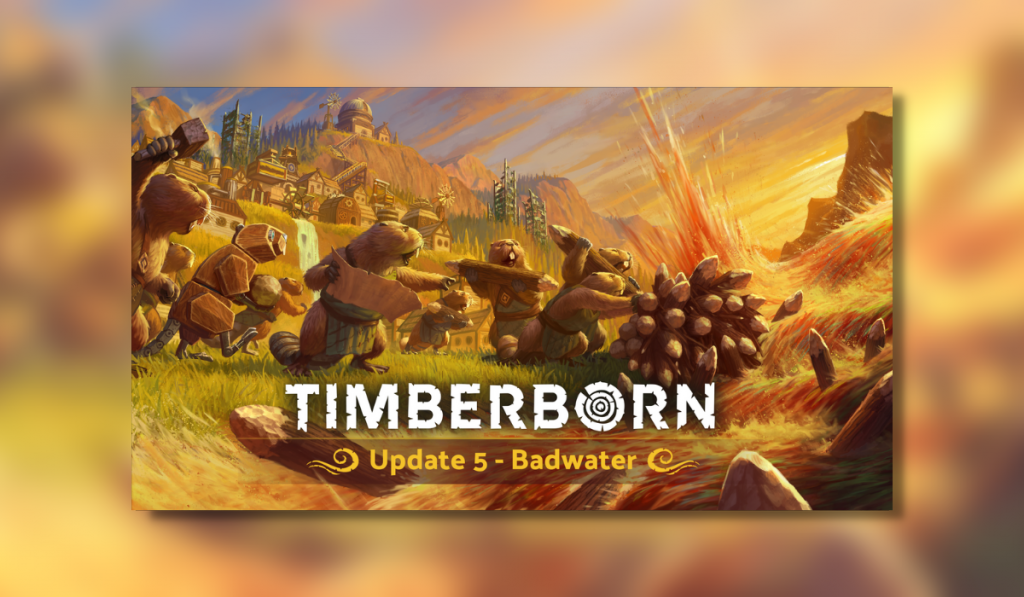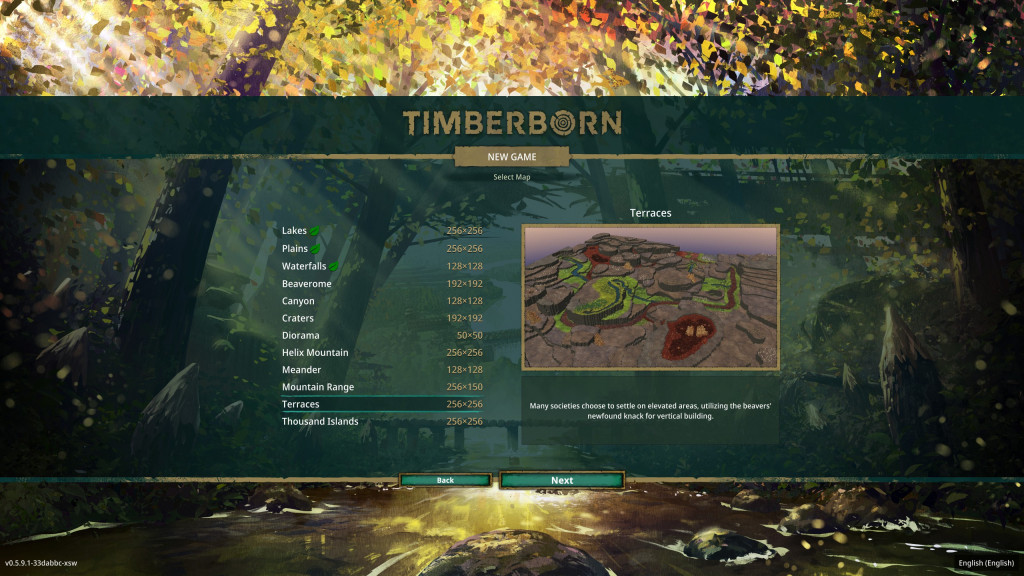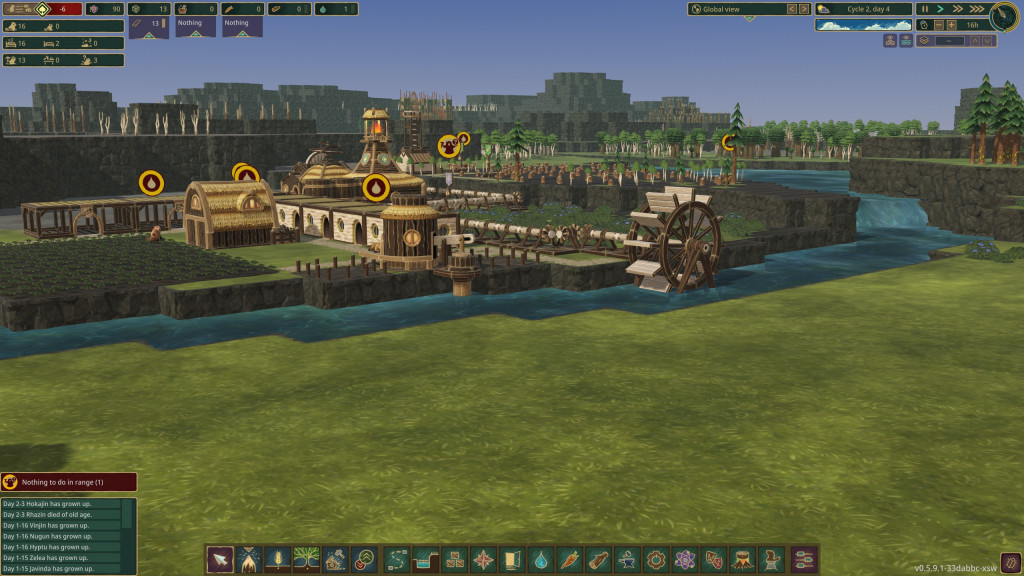
Timberborn by Polish devs Mechanistry, is a single-player city-building game that is available in Early Access on PC. With elements of The Settlers and Sim City, entwined with some serious furry beaver action, is this the builder game you’ve been knawing after?
Release the Power of the Beaver!
Without humans on the planet, Beavers are now the dominant species. Can you successfully grow from a small colony all the way to an engineering marvel of a city? Let’s see how I got on.

Gameplay
Established in 2019 and having been in early access since September 2021, Timberborn has just had it’s 5th update and shows no sign of slowing down.
Starting as the Folktails faction you begin your colonisation journey. There is another faction that you can unlock once you fulfil the criteria of a Wellbeing level of 15 called the Iron Teeth faction. Other factions, such as Common, Eager and Fancy beavers have been shown off during previous betas. These may come back in the future. Each faction has its own unique style of architecture, buildings and traits and is something to look forward to as the game evolves.
The next screen lets you select your map from a current list of 12. Worlds can be of various sizes and a preview can show how much fertile ground there is as well as the heights, water content, etc. I like how they have marked the first 3 as “beginner-friendly.” There is also a map editor for further creativity.

The level of difficulty can be chosen, with factors such as the amount of resources and duration of a weather phenomenon known as “bad tide” featuring. You can of course decide to completely customise the game if you wish, drilling down to the starting ages of beavers. Yes, this can get fairly in-depth if you choose to!
The basics of the gameplay are those of a typical city builder. Using the mouse to point and click, you start your village by building a district center monument that you create your village around. Next comes your workforce and basic buildings. Gathering resources such as wood, refining it, and then using it for production. Now where you would expect Timberborn to be fairly simple in that you are dealing with beavers, it is so much more than this.

Building
There are paths, as well as numerous structures used for residential housing, food, monuments, power, science, storage, water as well as the wellbeing of your furry villagers to look after. Each building gains a beaver with respective skills, that you can name, and watch age as the seasons pass. At night they all stop work for the day and sleep, giving you time to think about your next batch of construction, or simply fast forward to speed up to the next day.
Using the science building you can unlock new items to construct via Science points and carry on expanding your district. There is a limit to size before requiring a new district so plan accordingly!
While you would expect to be dealing with resources such as wood and metal, Timberborn delves into cogs, books, explosives, biofuel as well as ingredients such as chestnut, potatoes and maple syrup to name a few. Each item has lots of usage in advancing your beaver colony.

Obey Your Thirst
Water is a major resource and while you are not only pumping it to ensure that your villages all stay hydrated (very important) and fields irrigated, but you also harness the power of the river to produce electricity and power your buildings through elaborate twisting poles and cogs. It all gets very intuitive fairly quickly.
Where most city builder games focus more on the hard level of resources to be able to build, in Timberborn the wellbeing of the beavers must be attentively watched. It is worth noting that at the moment there is no combat.
The basic needs of hunger, thirst, sleep, shelter and wet fur are essential to be met otherwise you lose not only productivity but shorten the lifespan of your little fluffballs. While this element is not too difficult to maintain, unless there is a drought, the well beingness extends beyond this.

Nurture and Grow
Social life, aesthetics, awe, fun, knowledge and spirituality must also be satisfied through the construction and availability of specific items, buildings and monuments.
I found myself mesmerised watching the beavers go about their daily work life before curling up to go to sleep at the end of the day.
While you play through a cycle of seasons that includes droughts that turn your lush fertile grass and rushing rivers into hard brown unfarmable mud, the aforementioned “bad tide” is a rather nasty event to deal with.

When a bad tide occurs, it quickly takes over and contaminates land as well as the rivers. While it can come from a natural badwater spring source, it can also come from a water source as well. Beavers that are caught in it can become ill, affecting their productivity and slowing down your village day to day happenings. The construction of healers and medical beds is certainly something to unlock.
Once you have successfully grown your colony and met all of your requirements to keep the beaver colony happy, that is pretty much it. Building upwards if allowed and you can stack items up, allowing for towering and intuitive structures to be created.
Graphics & Audio
Timberborn has some genuinely lovely graphics going on. With detailed structures, the ability to zoom in on the action and spin the camera around you can easily immerse yourself within the game.
The beavers and their actions are well-animated and bring the world to life while the medieval-style villages you build are limited only to your imagination.
All of the gameplay I encountered was smooth and I suffered no frame rate drops or screen tearing when scrolling across the vast map.
The soundtrack to Timberborn by Zofia Domaradzka has a Settlers vibe to it, with gentle guitar melodies, strings and piano pieces melding into an epic theme of evolution and questing. It’s well worth a listen to, even as some background music when studying or reading.

Longevity
To play a map varies depending on how good you are at city builder-style games as well as your attention to your beaver’s needs. I would say that each game is easily around 24 hours long. The other maps as well as the map builder and unlockable Iron Teeth faction provide further gameplay while you experiment with different game styles and landscapes.
Final Thoughts
Timberborn felt slow to start with however once you have grasped the fundamentals there is a lot to be focussing on. From gathering resources, and unlocking items through science, to building and looking after your furry minions, can you maintain your colony?
For a game that has been developed by only a handful of people working from their homes, it is impressive to see such a well-refined game. The devs have been listening to the players and each update brings new concepts that have been based on feedback received. It is fantastic to see a company want to work with their audience and among other things, this has helped Timberborn be so successful.
Timberborn receives the Thumb Culture Gold Award!

Disclaimer: A code was received in order to write this review.

YouTube | Facebook | Twitter | Instagram | Discord | Podcast
